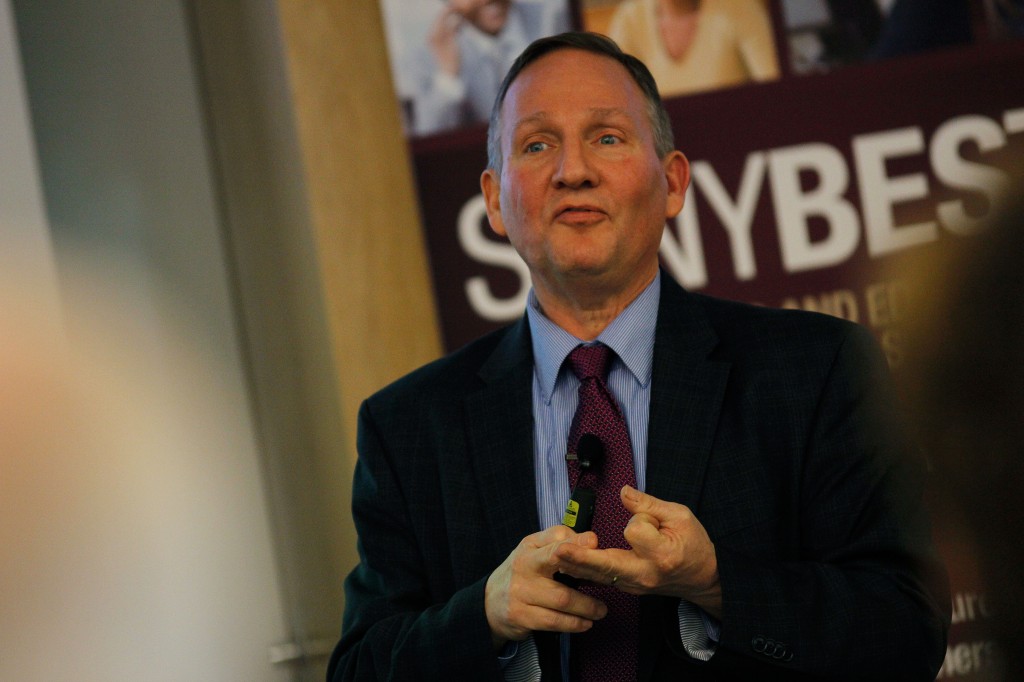
Without income from casino development and fracking, Downtown Binghamton residents may be looking for other sources of economic improvement. According to guests at the University Downtown Center on Thursday, energy and monetary conservation may be part of the solution.
The panel of speakers addressed recent improvements throughout the Southern Tier at the SUNY BEST (Business and Education Cooperative of the Southern Tier) event, “Inspiring Energy Initiatives: The Public and Nonprofit Sectors.” Six specialists from the region presented projects regarding energy conservation, spanning from specific reforms within Binghamton University to larger initiatives in neighboring areas.
Each project was oriented around saving both money and energy. Guy Hallgren, director of municipal facilities for utilities at Bath Electric Gas & Water Systems, presented a proposal for economic and environmental improvement within Bath, New York, a village an hour and a half outside of Binghamton.
The company is attempting to decrease wastewater, or water that is contaminated. They proposed switching from expensive conventional wastewater treatment processes, which involve energy-intensive methods of cleaning water that release pollutants such as nitrogen and ammonia, to a resource recovery hub that cleans water at a lower cost.
By using the new technology, waste would be cleaned to become energy for heat or electricity. Hallgren talked about separating nutrients from sludge and putting those nutrients through a process called anaerobic digestion, where microorganisms break down biodegradable material without oxygen to release energy hidden within the nutrients.
According to Hallgren, the new water treatment process would be environmentally sound, profitable and sustainable, eliminating roughly $100,000 in treatment costs per year for the village.
“We could have taken the conventional process to remove pollutants and conserve energy,” Hallgren said. “But I thought there was a better way to do this. A community is behind us, and they’re very supportive of this.”
Three representatives from Cornell University discussed actions the school is taking to reduce energy usage and make for a climate neutral campus. Erin Moore, sustainability engagement manager, said Cornell University hosts various competitions to create interest in saving energy.
Moore said the competitions are an effective way to save energy on campus, and other schools should follow suit.
“The goal is to have the students become more conscious about their actions and the impact their actions will have,” Moore said. “Once they leave the university, they’re more knowledgeable and can make better decisions when they need to manage their own utilities.”
One competition is called “Energy Smackdown,” and lasts from November to December. Students are encouraged to use the least amount of energy, such as water and lights, possible in their buildings. The competition is between dorm buildings and has saved roughly $15,000 in six weeks.
Sandy DeJohn, a utilities manager and campus sustainability coordinator at BU, spoke about changes in lighting fixtures within the University, a project that began over 10 years ago.
According to DeJohn, the campus made an executive decision to switch to LED lights in January 2004. LEDs are implemented in high usage areas like parking garages, campus streetlights and Glenn G. Bartle Library. Occupancy sensors, lights that turn on when movement is sensed, have also been employed in almost every building.
Since 2010, amount of energy usage per square feet within BU has been consistently decreasing. DeJohn said the University is continuing to switch to lights with both a lower price and energy usage, and that she hopes students recognize the benefits that will follow.
“I’m hoping students will notice the new fixtures that we have,” DeJohn said. “We don’t want to inconvenience users; we just want to save money so it can be directed to education and utility.”


